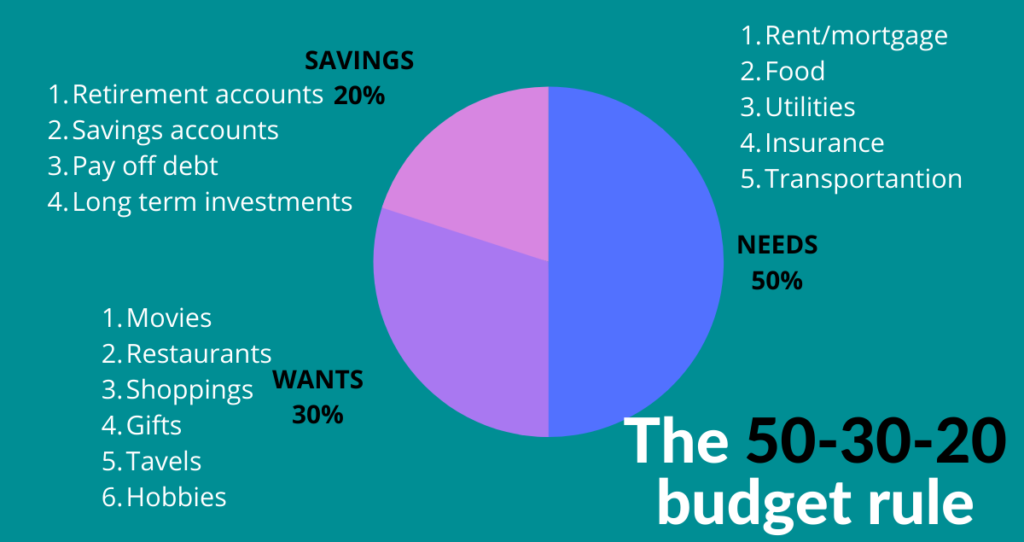The 50-30-20 budget rule is a budgeting rule that is simple and easy to follow. This rule is intended to help people spend their after-tax money appropriately. The rule states that you should allocate 50% of your after-tax money on needs, 30% on wants, and save 20%.
The 50-30-20 budget rule was made popular by Elizabeth Warren in her book, All Your Worth: The Ultimate Lifetime Money Plan, according to Investopedia. This budgeting rule does not allocate funds on every item in a budget. Instead, it allocates a percentage of after-tax funds in three groups which are savings, wants, and needs.
50% toward needs
The money you spend on your needs plays an important role in your finances. According to the 50-30-20 budget rule, 50% of your income must go to things you need. The question is, what is a need?
A need is something important in your life that you cannot live without. For example, you cannot live without food or a place to stay.
Needs differ from one person to another. However, the following are some of the common needs that 50% of your income should cover.
- Rent/mortgage
- Food
- Utilities
- Health insurance
- Transportation
- Etc
For example, let’s assume that your net income is $5,000 every month. The 50-30-20 rule suggests that 50% of this income should go be used to cover all your needs. With this rule, $2,500 must be used to cover your needs.
Anything you allocate to your needs above 50% will be in violation of this rule. No matter how many expenses you have, make sure that all your needs can be covered by 50% on your net income.
30% toward wants
Here comes the part that everyone enjoys but also the part that causes the most financial troubles.
The 50-30-20 rule suggests that 30% of your net income should be spent on your wants. Wants differ from one person to another depending on income and lifestyle.
The following are common wants that you probably share with others.
- Movies
- Eating out in restaurants
- Endless shoppings
- Gifts
- Funding your travels and vacations
- Funding all your hobbies, etc
From our example, 30% of your net income($5,000) will be $1,500. All your wants must fall into this value ($1,500) and nothing more.
20% toward savings
The remaining percentage of your income will go to savings. There are many forms of savings.
Most people think that saving money has only 3 meanings: Putting money under the mattress, in a saving account, or in a piggy for later use.
The truth of the matter is that saving takes many forms and these vary from one person to another.
The money you dedicate to your financial goals is considered to be savings. The following are ways you can use that 20% toward your savings.
- Put a portion on your money into retirement accounts
- Pay off your debts
- Savings account contributions
- Investments such as CD, Mutual Funds, etc
Although this rule sounds simple and straightforward, most people do not meet its requirements. There is a lot of confusion between what is a need and what is a want. So, people treat restaurant expenses and shopping as needs.
By the time they get to actual wants, there is nothing left. What they do is use the little money they have left to satisfy their never-ending spending desires.
Not knowing your priorities and spending without budgeting your money is a big mistake that will prevent you from achieving the 50-30-20 budget rule.
Is using the 50-30-20 budget rule a good money strategies
The 50-30-20 rule will help you get started with managing your money. However, I personally think that you need to make some adjustments to this rule in order to increase your savings.
It is important to recognize that the 50-30-20 rule is effective and it is reasonable to spend 50% of your net income toward your needs.
However, I don’t think that you should spend 30% of your net income on your wants on top of the 50% you spend on needs.
What this means is that your wants and needs are taking 80% of your net income. Out of that $5,000 we used in our example, only $1,000 will go to your savings. This is not a smart budgeting strategy.
What I think is a much better method is to make the rule a 50-20-30.
This modified budgeting rule can help you save 30% of your net income and leaves you 20% to spend on your wants. You can also take this one step further and use 40-10-50 (40% on needs, 10% on wants, and 50% on saving). I call this method an aggressive saving and it works well for people who are close to retiring.
The idea here is that the 50-30-20 rule can be modified to meet your financial needs. The smartest decision you can make is to reduce your expenses and increase your savings. The more money you save the faster you will achieve your financial stability.








